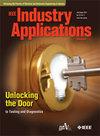定频LLC变换器的二次谐波感应谐振模式
IF 4.5
2区 工程技术
Q2 ENGINEERING, ELECTRICAL & ELECTRONIC
引用次数: 0
摘要
固定频率操作的有限责任公司转换器可以提供一个固定的电压增益与电流隔离之间的输入和输出。然而,当应用于两级AC/DC变换器时,流过LLC变换器的等效电流,即功率流,不仅包含直流电流,还包含双线频率的二次谐波电流(SHC)。本文揭示了LLC变换器有三种不同的谐振模式,它们具有不同的SHC转移特性。如果参数设计不当,LLC变换器传递的SHC甚至可能高于交直流阶段的SHC,导致每半个交流周期谐振工作不连续。这种现象增加了开关器件的直流链路纹波电压和电流应力,降低了效率,在实际应用中应尽量避免。为了对有限责任变换器的行为进行数学建模,本文采用了考虑有限责任变换器单向功率传输特性的等效电路模型。该等效模型可用于计算不同直流链路设计下的SHC分布,比典型等效模型具有更好的建模精度。通过对两级输入串联输出并联固态变压器的仿真和实验测量,验证了上述分析的正确性。本文章由计算机程序翻译,如有差异,请以英文原文为准。
Second Harmonic Induced Resonant Modes of Fixed-Frequency Operated LLC Converters
The fixed-frequency operated LLC converters can provide a fixed voltage gain with galvanic isolation between the input and output. However, when applied in two-stage AC/DC converters, the equivalent current that flows through the LLC converter, which corresponds to the power flow, contains not only a DC current but also a second harmonic current (SHC) at the double line frequency. This paper reveals that the LLC converter has three different resonant modes with different SHC transfer characteristics. With improper parameter design, the SHC transferred by the LLC converter could be even higher than the SHC from the AC/DC stage, leading to discontinuities of resonant operation in every half AC cycle. This phenomenon increases the DC link ripple voltage and current stress of switching devices, reduces efficiency, and should be avoided in practice. To mathematically model the behavior of LLC converters, an equivalent circuit model considering the unidirectional power transfer characteristic of LLC converters is employed in this paper. The equivalent model can be used to calculate the SHC distribution with different DC link designs and provides better modeling accuracy than typical equivalent models. The analysis is verified by simulations and experimental measurements on a two-stage input-series-output-parallel solid-state transformer.
求助全文
通过发布文献求助,成功后即可免费获取论文全文。
去求助
来源期刊

IEEE Transactions on Industry Applications
工程技术-工程:电子与电气
CiteScore
9.90
自引率
9.10%
发文量
747
审稿时长
3.3 months
期刊介绍:
The scope of the IEEE Transactions on Industry Applications includes all scope items of the IEEE Industry Applications Society, that is, the advancement of the theory and practice of electrical and electronic engineering in the development, design, manufacture, and application of electrical systems, apparatus, devices, and controls to the processes and equipment of industry and commerce; the promotion of safe, reliable, and economic installations; industry leadership in energy conservation and environmental, health, and safety issues; the creation of voluntary engineering standards and recommended practices; and the professional development of its membership.
 求助内容:
求助内容: 应助结果提醒方式:
应助结果提醒方式:


